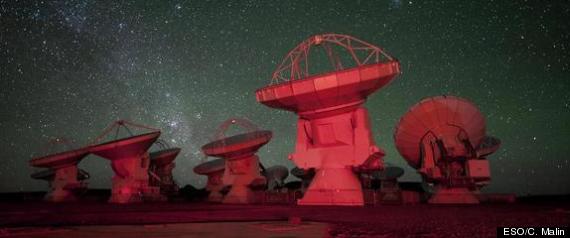
Alma is our best chance of alien contact discovery!
The Atacama Large Millimetre Array (Alma) radio telescope has taken a decade to build and cost $1.4bn. Yet although it is operating at less than a 10th of its capacity – it will be up to a year before it is used at maximum power – it is already yielding new insights into the origins of galaxies, stars and planets.
Most scientists believe that statistically it is likely that life exists somewhere else in the universe, based on the number of stars like our own Sun.
More than 2,700 candidate planets orbiting other stars have been identified – the vast majority are expected to be confirmed as true “exoplanets”.
Astronomers using Alma have already identified sugar molecules in the gas surrounding a young Sun-like star – the first time sugar has been found in space. “The discovery shows that the building blocks of life are in the right place at the right time to be included in planets forming around the star,” the Joint Alma Observatory says.
The project is an international collaboration in which the European Southern Observatory (ESO), a consortium of 15 countries including the UK, whose subscription is paid via the UK Science and Technology Facilities Council , has played a leading role.
Alma is designed to observe longer wavelengths beyond the visible light spectrum and it is in this part of the spectrum that the chemicals essential to life such as water can be detected through spectroscopic analysis.

One of the earliest discoveries made with Alma, which has greatly excited astronomers, is the detection of glycolaldehyde – a primitive form of sugar – in the gas surrounding a young star.
Glycolaldehyde is one of the building blocks of ribonucleic acid (RNA), which in turn is one of the foundations of life.
In the search for extraterrestrial creatures or plants, the first step is to identify where the conditions are right for life to occur. The discovery of complex molecules such as sugar gives scientists confidence that they are looking in the right place.
Other molecules essential to life that have been discovered elsewhere in the universe include ethanol (alcohol), formaldehyde, carbon monoxide and ammonia.
Given the spectrum of radio waves within which it operates, Alma is able to spot these complex molecules and direct astronomers to where life may be formed.
Source NASA, Independent
Originally posted 2016-05-03 20:28:24. Republished by Blog Post Promoter

![Alma-the-alien-hunting-telescope[1]](https://coolinterestingnews.com/wp-content/uploads/2013/03/alma-the-alien-hunting-telescope1.jpg)










